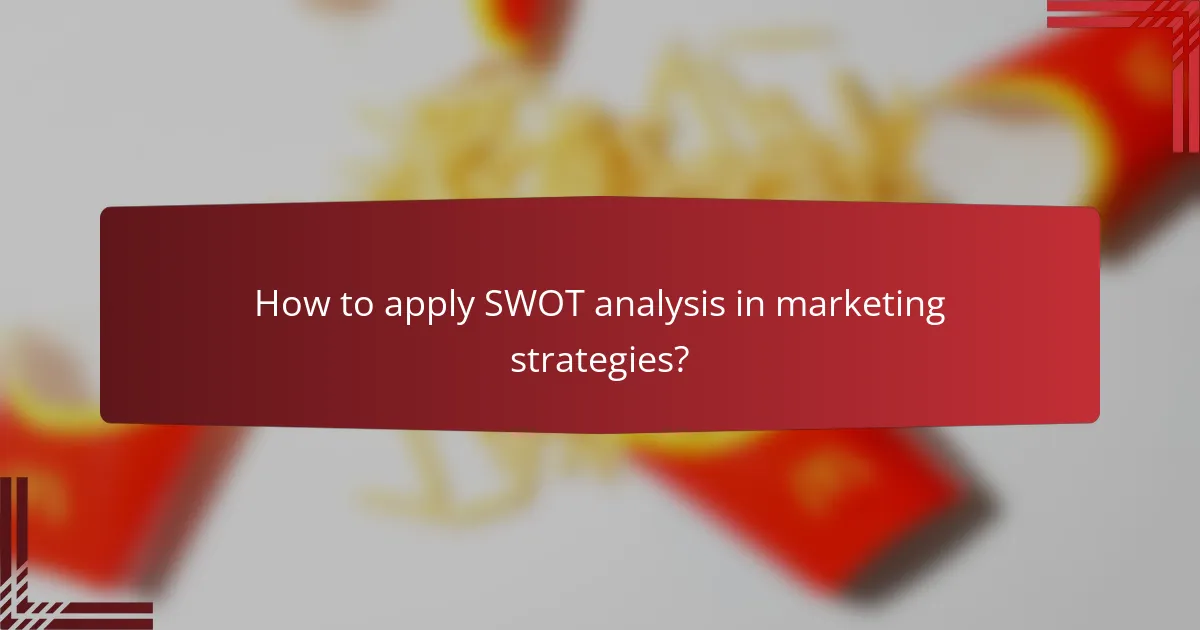SWOT analysis is a vital strategic tool that enables organizations to assess their internal strengths and weaknesses alongside external opportunities and threats. By systematically evaluating these factors, businesses can make informed decisions that enhance their competitive edge and drive growth. This structured approach not only aids in identifying areas for improvement but also helps in mitigating potential risks in the dynamic business environment.

How to conduct a SWOT analysis effectively?
To conduct a SWOT analysis effectively, start by gathering a team to identify the internal strengths and weaknesses, as well as the external opportunities and threats facing your organization. This structured approach helps in making informed strategic decisions based on a comprehensive understanding of your business environment.
Identify internal strengths
Internal strengths are the attributes and resources that give your organization a competitive advantage. Consider factors such as skilled personnel, strong brand reputation, unique technologies, or efficient processes. For example, a company with a loyal customer base and innovative products can leverage these strengths to enhance market presence.
To identify strengths, conduct brainstorming sessions with team members and utilize tools like surveys or SWOT workshops. Document these strengths clearly, as they will serve as the foundation for your strategic planning.
Assess internal weaknesses
Internal weaknesses are areas where your organization may be at a disadvantage compared to competitors. These can include gaps in skills, limited resources, or outdated technologies. For instance, a lack of digital marketing expertise could hinder a company’s online presence.
To assess weaknesses, encourage open discussions among team members and gather honest feedback. Create a list of weaknesses and prioritize them based on their potential impact on your business objectives.
Explore external opportunities
External opportunities are favorable conditions or trends in the market that your organization can exploit for growth. These might include emerging markets, technological advancements, or changes in consumer preferences. For example, a shift towards sustainable products can present new avenues for companies focused on eco-friendly solutions.
To explore opportunities, conduct market research and analyze industry trends. Networking with industry professionals and attending relevant conferences can also provide insights into potential opportunities.
Evaluate external threats
External threats are challenges posed by the environment that could negatively impact your organization. These can include economic downturns, increased competition, or regulatory changes. For instance, new regulations in your industry could impose additional costs or operational challenges.
To evaluate threats, keep abreast of industry news and competitor actions. Regularly review your SWOT analysis to adapt to changing circumstances, ensuring your organization remains resilient in the face of potential threats.

What are the benefits of a SWOT analysis?
A SWOT analysis provides a structured framework for evaluating an organization’s strengths, weaknesses, opportunities, and threats. This tool helps businesses identify internal and external factors that can impact their success, leading to more informed strategic decisions.
Improved strategic planning
Conducting a SWOT analysis enhances strategic planning by offering a clear view of the current business landscape. By identifying strengths, organizations can leverage these assets to capitalize on opportunities while addressing weaknesses that may hinder progress.
For example, a company with strong brand recognition can focus on expanding its market share in new regions. Conversely, recognizing weaknesses, such as limited resources, allows for better allocation of efforts and investments.
Enhanced decision-making
SWOT analysis improves decision-making by providing a comprehensive overview of factors influencing a business. This clarity enables leaders to make choices that align with their strategic goals and market realities.
For instance, if a company identifies a growing trend in sustainable products as an opportunity, it can prioritize investments in eco-friendly initiatives. This proactive approach minimizes risks and maximizes potential returns.

How to apply SWOT analysis in marketing strategies?
Applying SWOT analysis in marketing strategies involves evaluating your business’s strengths, weaknesses, opportunities, and threats to inform decision-making and strategic planning. This structured approach helps identify key areas for growth and improvement while mitigating risks.
Target market identification
Identifying your target market is crucial for effective marketing strategies. Start by analyzing your strengths to determine which customer segments can benefit most from your products or services. Consider demographics, psychographics, and purchasing behaviors to create detailed customer profiles.
Utilize surveys, focus groups, and market research to gather data on potential customers. This information will help you tailor your marketing messages and channels to resonate with your identified audience, ensuring a higher return on investment.
Competitive advantage assessment
Assessing your competitive advantages involves examining your strengths in relation to competitors. Identify unique features, superior quality, or exceptional customer service that set your business apart. This analysis can highlight areas where you can leverage your strengths to capture market share.
Consider conducting a competitor analysis to understand their weaknesses and market positioning. By aligning your marketing strategies with your competitive advantages, you can effectively differentiate your brand and attract more customers.

What are common pitfalls in SWOT analysis?
Common pitfalls in SWOT analysis include neglecting external factors and failing to prioritize findings. These mistakes can lead to incomplete assessments and ineffective strategic planning.
Overlooking external factors
One major pitfall in SWOT analysis is overlooking external factors that can impact an organization. This includes market trends, economic conditions, and competitive dynamics. Ignoring these elements can result in an overly optimistic or pessimistic view of the organization’s strengths and weaknesses.
To avoid this mistake, regularly review external data sources such as industry reports or market research. Engaging with stakeholders can also provide insights into external influences that may not be immediately apparent.
Failing to prioritize findings
Another common error is failing to prioritize findings from the SWOT analysis. When all identified strengths, weaknesses, opportunities, and threats are treated equally, it can lead to confusion and indecision. Prioritization helps focus resources on the most critical factors that will drive strategic decisions.
To effectively prioritize, consider using a scoring system or matrix to evaluate the impact and likelihood of each factor. This approach allows teams to concentrate on the most significant issues, ensuring that strategic initiatives align with organizational goals.

How to integrate SWOT analysis with PEST analysis?
Integrating SWOT analysis with PEST analysis allows organizations to combine internal strengths and weaknesses with external opportunities and threats. This holistic approach enhances strategic planning by providing a clearer picture of the business environment and internal capabilities.
Combining internal and external assessments
To effectively combine internal assessments from SWOT with external evaluations from PEST, start by identifying key strengths and weaknesses within your organization. Then, analyze the political, economic, social, and technological factors that could impact these internal elements. For instance, a strong brand reputation (strength) could be leveraged in a growing market (opportunity) while regulatory changes (threat) might challenge operational efficiency (weakness).
Consider creating a matrix that aligns internal factors with external influences. This can help visualize how strengths can capitalize on opportunities or mitigate threats, while weaknesses may be exacerbated by external challenges.
Creating a comprehensive strategy
A comprehensive strategy emerges when insights from both analyses are synthesized into actionable plans. Use the combined findings to prioritize initiatives that leverage strengths against opportunities or address weaknesses in light of threats. For example, if a company has a technological edge (strength) and faces increasing competition (threat), investing in innovation could be a strategic response.
Regularly revisit and update the integrated analysis to adapt to changing conditions. This ensures that the strategy remains relevant and responsive to both internal dynamics and external pressures, ultimately enhancing the organization’s resilience and competitive advantage.

What tools can assist in SWOT analysis?
Several tools can aid in conducting a SWOT analysis effectively, including templates, software applications, and collaborative platforms. These resources streamline the process, ensuring that all relevant factors are considered and organized clearly.
SWOT analysis templates
SWOT analysis templates provide a structured format for identifying strengths, weaknesses, opportunities, and threats. They typically include sections for each component, allowing users to fill in details specific to their organization or project.
Many templates are available online for free or for purchase, ranging from simple one-page documents to more comprehensive multi-page formats. Using a template can help ensure that no critical area is overlooked and facilitate discussions among team members.
When selecting a template, consider your specific needs. For instance, a startup might require a more detailed template to explore various market opportunities, while a well-established company may focus on internal strengths and weaknesses. Look for templates that allow for easy customization to fit your context.


